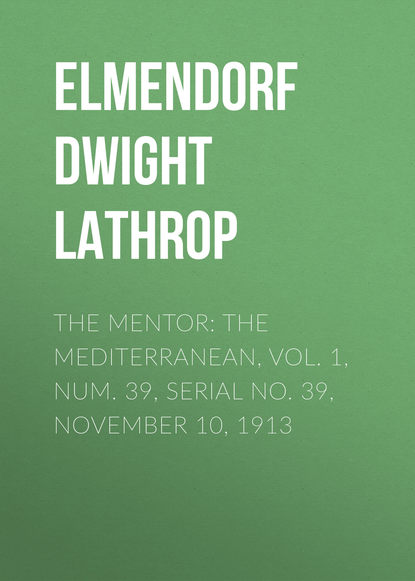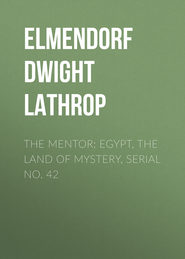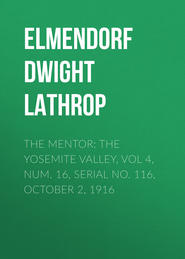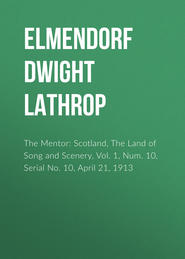По всем вопросам обращайтесь на: info@litportal.ru
(©) 2003-2024.
✖
The Mentor: The Mediterranean, Vol. 1, Num. 39, Serial No. 39, November 10, 1913
Настройки чтения
Размер шрифта
Высота строк
Поля
Vol. 1 No. 39
ANNUAL SUBSCRIPTION, FOUR DOLLARS. SINGLE COPIES TWENTY CENTS. FOREIGN POSTAGE, SEVENTY-FIVE CENTS EXTRA. CANADIAN POSTAGE, FIFTY CENTS EXTRA. ENTERED AT THE POST OFFICE AT NEW YORK, N. Y., AS SECOND-CLASS MATTER.
Editorial
The Mentor has reached the farm. We have heard of its work in cities and towns and small settlements. We have had assurance of its acceptance by professional men, business men, educators, reading societies and of the place it has assumed in the home. We have been waiting to hear from the farm – and wanting to hear, for it seems to us that a plan that carries information in a popular and interesting way to the public must be a welcome visitor to any intelligent farm family.
***
And now comes the first voice from the farm, and it is in its way the finest, freshest, and cheeriest message that we have had. It is so full of simon-pure human notes that we are going to give it to the readers of The Mentor in full. We are sure it will interest all of our readers as much as it gratifies us:
“The Mentor Association, Inc., New York City.
“Dear Sirs: Thank you so much for your offer for becoming a charter member. I think The Mentor is splendid and I desire most keenly to accept, but alas, I am poor. My husband and I are young and struggling farmers. We are in a way of becoming comfortably situated, but at present, though we own quite a bunch of stock, implements, some property, etc., we really have little actual cash, and have to plan with economy and care to make every penny count. The grain in the bins means money, but must pay for labor and other expenses until another crop is harvested next year. The cream from the cows pays for food and clothing and incidentals.
***
“I have decided to save my dimes for The Mentor, and to forego a renewal of one of my magazines. My husband spends some of his dimes for tobacco; I will save mine for The Mentor, even if it takes fifty, and share my joy with him. When I read the list of previous numbers, I longed for a complete set; but I am of a cheerful disposition, so am consoling myself in thinking I will some time have some of them. Best wishes to you in your great plan, and many thanks also for the two blue coupons for my friends.”
***
We have always claimed for The Mentor a “wide human reach.” Surely it must have it when a single number can bring a message like this back to us from a far western farm.
***
And now a word about the blue coupons. They are Mentor Presentation Coupons, and they have been prepared for the use of members of The Mentor Association. We believe that every member of The Mentor Association has many friends who would be delighted to know The Mentor, and to become acquainted with the advantages which the Association affords. In this busy work-a-day world people are often too busy to pass on a good thing to their friends. Sometimes it is not because they are too busy; it is simply because there is no convenient way of passing on the information. Some of our readers have told us that if we would supply them with convenient material for making The Mentor known to others it would be appreciated and used.
***
So we have prepared the blue coupon specially with the thought of interesting your friends. Send to us for some of these coupons. They will enable you to place free copies of The Mentor with friends that you think will appreciate them. You enjoy The Mentor. Give your friends a chance to enjoy it too.
ALGIERS, ALGERIA
Less than a century ago the Barbary Coast, and the city of Algiers in particular, was a nest of pirates. All the principal nations of the world paid them tribute. Their nation was known as the “scourge of Christendom.” Up to the year 1800 the United States alone had poured over $2,000,000 into the coffers of the dey, or ruler. But it was our country, the youngest of all, that put a stop to this cowardly practice of paying toll for immunity from attack on the high seas.
In 180 °Captain Bainbridge, in a United States warship, went to Algiers, taking the usual “presents.”
The dey commanded him to become his messenger and carry his despatches to Constantinople. “The English, French, and Spanish captains have always done this for me. You also pay me tribute, and you also are my slaves,” he said insultingly.
Not daring to disobey without orders from home, Bainbridge did as he commanded; but this was too much for the American people. After the War of 1812 Commodore Decatur served notice on the dey that never again would the United States pay him tribute in money. The dey replied that some powder for his fleet would be acceptable.
“The powder you shall have, if you insist,” answered Decatur; “but the bullets go with it.”
The dey refused the present; but ordered his ships to destroy all American shipping hereafter. These orders having been carried out, Commodore Decatur sailed again for Algiers, and forced the terrified dey to sign a treaty which gave to American ships immunity forever after.
In 1816 the English attacked Algiers; but it was not until fourteen years later that the pirates’ nest was destroyed for good. On June 13, 1830, the dey of Algiers slapped the French consul in the face, and brought down upon himself the wrath of France in the shape of an army of forty thousand men. On the fourth of July, Algiers surrendered, and the “scourge of Christendom” was ended.
Algiers, the French capital of Algeria, has 154,000 inhabitants. It is located on the west side of the Bay of Algiers, and is the most important coaling station on the whole coast of northern Africa.
In Roman times the famous Biblical town of Cæsarea occupied almost the same site. The present city was founded about 935; but Algiers was of little importance until after the expulsion of the Moors from Spain, many of whom settled in the city. From then on until its capture by France, Algiers was the chief seat of the Barbary pirates. The French have greatly improved the place.
THE RIVIERA
The Riviera is a narrow belt of coast that lies between the mountains and the sea all round the Gulf of Genoa in the north of Italy, extending from Nice on the west to Spezia on the east. Part of the Riviera is in France and part in Italy. The Riviera di Ponente (“the coast of the setting sun”) lies between Nice and Genoa. The part between Genoa and Spezia is called the Riviera di Levante (“the coast of the rising sun”).
The climate of the Riviera is very mild, and it is one of the most beautiful regions on earth. All this district is open to the south and sheltered by the mountains on the north and east. The landscape is delightfully varied, – here a bold and lofty promontory, there a wooded hill, and down near the coast richly cultivated plains. The traveler passes steep and frowning cliffs, whose bases are washed by the surf of the Mediterranean, whose summits are crowned by the venerable ruins of towers erected in bygone ages for protection against pirates.
Many of the towns in the Riviera are situated in fertile valleys or on picturesque hills; while others are perched like nests among the rocks. Little churches and chapels peering from the somber foliage of cypresses, and gigantic gray pinnacles of rock frowning upon the smiling plains, frequently enhance the charms of the scenery; while the vast expanse of the Mediterranean, with its ever changing hues, dazzles the eye with its beauty.
Olives, with their grotesque and gnarled stems, are grown on great plantations in the Riviera. The warm climate produces luxuriant growths of figs, vines, citrons, oranges, oleanders, myrtles, and aloes. Bright green pine forests meet the eye, and even palms are seen occasionally.
Thousands of visitors spend the winter in the chain of towns and villages that stretches from one end of the Riviera to the other, – Nice; Monte Carlo in Monaco, the little independent principality; Mentone, the last town in the French Riviera; Bordighera; Pegli; Nervi; Spezia; and many others. In summer the Italians visit these resorts for sea bathing.
The only drawback to the Riviera is its liability to earthquakes, of which there were four in the last century alone.
A railway runs close along the shore all through the Riviera. The distance from Nice to Genoa is 116 miles, and from Genoa to Spezia 56 miles. In the latter stretch the railroad burrows through the many projecting headlands by means of more than 80 tunnels.
The poets Lord Byron and Shelley both lived and wrote on the shores of the Gulf of Spezia, and Charles Dickens, the great English novelist, wrote his well known story, “The Chimes,” at Genoa.
MONTE CARLO, MONACO
It is a curious thing that the smallest country in Europe is also one of the most visited. This is the little independent principality of Monaco. Monaco is only about eight square miles in area; and it is two and a quarter miles long. The population of the entire principality is only 19,000.
Monaco – the city of Monte Carlo in particular – is so greatly visited for two reasons, – its charming climate and situation, and its gaming tables. It is an excellent health resort, but is world famous as a gambling place. It was in 1861 that a man named François Blanc obtained a gambling concession in Monaco for fifty years from Charles III. A stock company later got hold of this concession, and in 1898 it was extended to 1947, in return for a payment to the prince of $2,000,000 in 1899 and another payment of $3,000,000 in 1913. In addition to this Monaco obtains from the company an annual tribute of $350,000, increasing to $400,000 in 1917, $450,000 in 1927, and $500,000 in 1937. These great tributes make it possible for the inhabitants of Monaco to be entirely exempt from taxation.
In the principality of Monaco there are three cities, – Monaco the capital, Condamine, and Monte Carlo. At one time the towns of Mentone and Roquebrune belonged to Monaco; but they were ceded to France in 1861 for $800,000. The city of Monaco occupies the level summit of a rocky headland, rising about 200 feet from the shore. Here the prince has his palace.
Monte Carlo lies to the north of the Bay of Monaco, where are gathered the various buildings of the Casino of Monte Carlo, with the beautiful gardens, and many villas and hotels.
The history of this little principality is an interesting one. It seems that long ago a temple of Heracles was built on the Monaco headland by the Phoenicians. The same god was worshiped there by the Greeks at a later date, and they gave the place its name. The Grimaldis, the present ruling family of Monaco, became associated with the place in the tenth century; but they did not come into permanent possession until much later.
Monaco in the fourteenth century was notorious for its piracies, and the right to exact toll from vessels passing the port continued to be exercised until the end of the eighteenth century.
For many years Monaco was an ally of France; but in 1525 it came under the protection of Spain. Then in 1641 Honoré II threw off the Spanish yoke and made himself an ally of France. The National Convention annexed the principality to France in 1793; but by the Treaty of Paris in 1814 it was restored to the Grimaldis. Finally in 1860 Monaco passed again under French protection.
The present ruler of Monaco, Prince Albert, was born in 1848 and succeeded his father, Prince Charles III, in 1889. The prince is absolute ruler, as there is no parliament in the principality. He appoints a small council to advise him on matters of state. He also has power to appoint the mayors and other municipal authorities.
NICE, FRANCE
The Massilians founded Nice 2,500 years ago. Its situation soon made it one of the busiest trading stations on the Ligurian coast. But in those days the price of prosperity was continual warfare. The Saracens descended on Nice in 729; and though at that time they were repulsed, in the next century they captured the city and burned it.
All through the Middle Ages, Nice had its share in the wars and disasters of Italy. It had to fight both Genoa and France, and on the sea its merchantmen were attacked by Barbary pirates. Finally in 1388 it placed itself under the protection of the counts of Savoy. In this way it was protected on land and could devote its strength to taking care of the pirates.
But bad fortune seemed to hover over the city. Invading armies devastated the land, and then pestilence and famine raged for several years. In 1543 Nice was attacked by the united forces of Francis I and Barbarossa. After a brave resistance the city was compelled to surrender, and was pillaged by the conquerors.
Then followed many years of alternate war and peace; until finally Nice was captured in 1792 by the armies of the French republic. It continued to be a part of France till 1814; but at that time it reverted to Sardinia. Then, in 1860, by a treaty between the Sardinian king and Napoleon III, it was again transferred to France, in whose possession it is today.
The city of Nice is a great winter resort for invalids and others from all parts of Europe. It is situated on the Mediterranean 100 miles east of Marseilles. A steep limestone hill, 308 feet in height, running back for some distance from the shore, is the historical nucleus of the town. It used to be crowned by a castle, which, previous to its destruction by the Duke of Berwick in 1706, was one of the strongest fortresses on the coast. Now it is a public pleasure ground.











